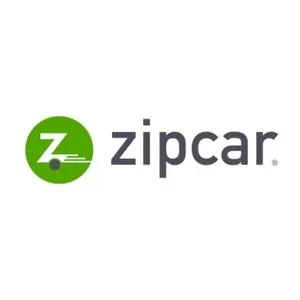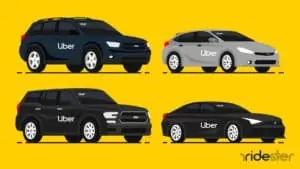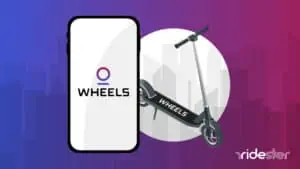An Overview of How to Use Zipcar
- Zipcar offers a car-sharing service that requires users to sign up, choose a membership plan, and book vehicles through an app.
- Members can book Zipcars hourly or daily, with gas, insurance, and 180 miles per day included in the cost.
- A physical Zipcard or the app can unlock reserved vehicles, which must be returned to their original parking spot.
- Zipcar charges fees for late returns, unreported damages, and insufficient gas refill upon return.
How to Use Zipcar: Signing Up
Signing up for Zipcar couldn’t be easier. All you have to do is install the app and provide your information. Then, you’re ready to hit the road.
There aren’t any requirements to join Zipcar. As long as you have a valid driver’s license and are over 18, you can become a member.
The sign-up process is incredibly simple; you only have to follow these steps:
- Start by downloading the Zipcar app on your phone.
- Create an account by inputting your email and password.
- Provide your name and birthdate, as found on your driver’s license.
- Choose a membership plan, which is either monthly or annually if you’re in the United States.
- Afterward, you’ll need to pay with a debit or credit card.
- Next, upload a clear picture of your driver’s license.
- After providing your valid driver’s license, Zipcar will need to verify your identity.
- Typically, you’ll get verified and approved immediately and can start booking trips.
Keep in mind that Zipcar will take a couple of days to process your application.
This usually happens if your driver’s license isn’t valid in the country you’re driving in. In this case, you’ll have to fill out a declaration form.
Zipcar’s users must be over 21. However, the car rental company is flexible, giving college students access to the vehicles so that they can get around campus.
For this reason, if you’re between 18 and 21, you’ll need to also provide a college ID.
You’ll Need to Subscribe to Rent a Zipcar
When you sign up for Zipcar, you’ll need to pick a membership plan, which might seem confusing at first, especially if you’re new to the app.
Zipcar’s membership structure is straightforward. You have the option to pay either a monthly or yearly fee, based on the plan you choose.
Fortunately, both plans offer the same benefits and insurance coverage, and there’s a free trial for the first month.
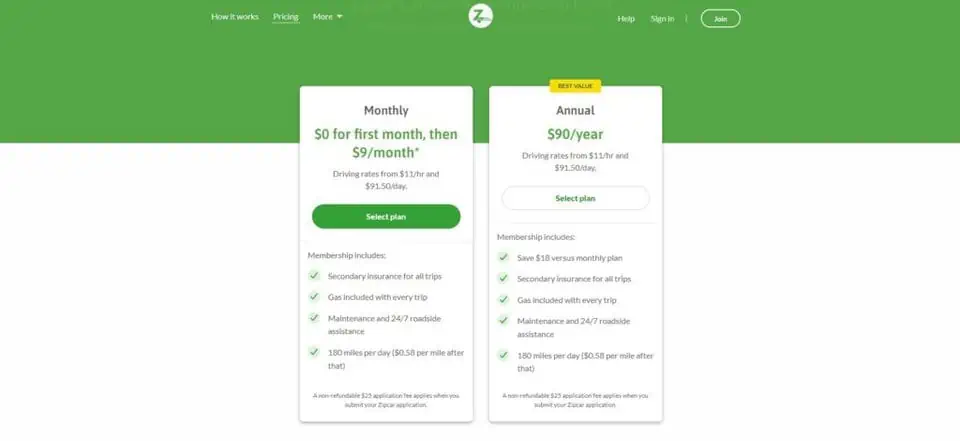
For starters, there’s a monthly plan at $9 a month. This is a good option if you’re just trying Zipcar out and might not want to continue after the first month.
On the other hand, the annual plan is perfect for those who regularly need a car and are ready to commit for a longer period. It’s priced at $90 a year, which saves you $18 compared to paying monthly.
As for the benefits included in the membership, you’ll get the following:
- Secondary insurance on all trips
- Car maintenance and 24/7 roadside assistance
- Included gas with all trips
- Free 180 miles every day
Don’t worry though. The process of canceling a Zipcar membership is fairly straightforward.
Pro Tip: Use a Zipcar promo code during signup to claim discounts and/or get fees waived.
The company runs random promotions, so check back often to get the best deal.
Finding and Reserving a Zipcar
When you’re ready to book a Zipcar, you’ll find a list of all available vehicles near you. The app also enables you to book a car in advance, as well as filter by the model of the vehicle.
First, start by searching for a vehicle. You’ll enter a street name and city, a pickup time, and return date.
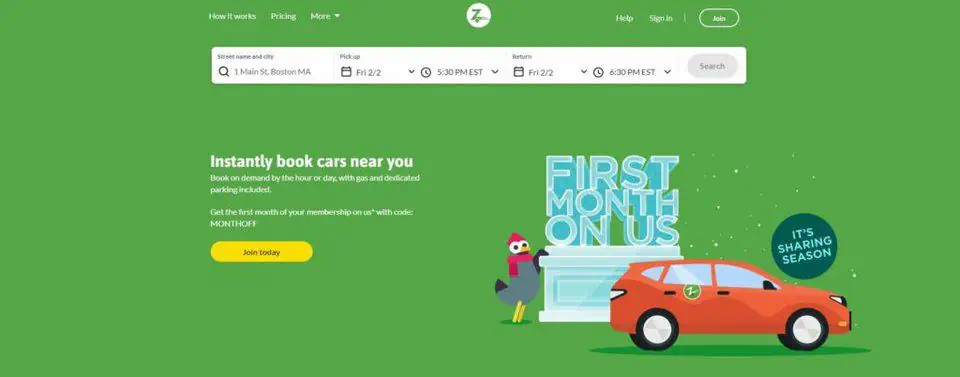
The system will search for vehicles and then return the available options for your selected criteria.
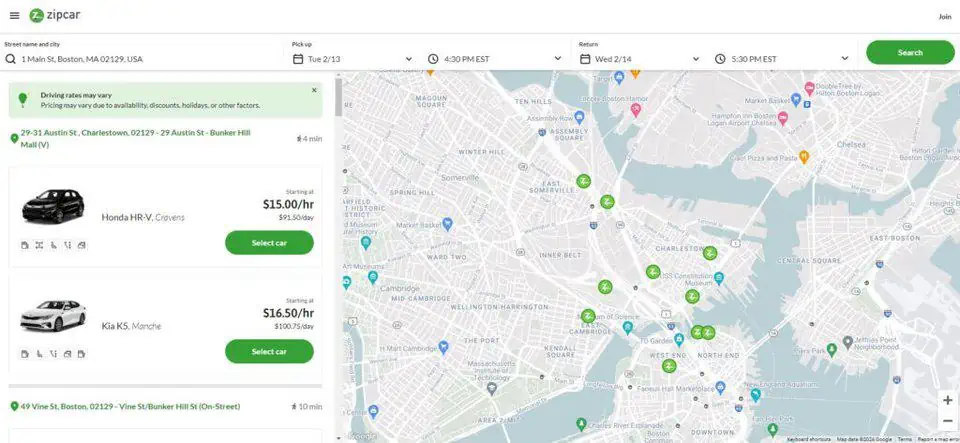
Select the vehicle option that works best for you. Typically, the locations are clumped together like you see on the map in the screenshot above.
I suggest selecting one after carefully considering traffic, vehicle type, and price.
When selecting a vehicle, you’ll notice that Zipcar does a really good job of providing exact addresses and details about the pickup location. This can be very helpful when planning pickups and dropoffs.
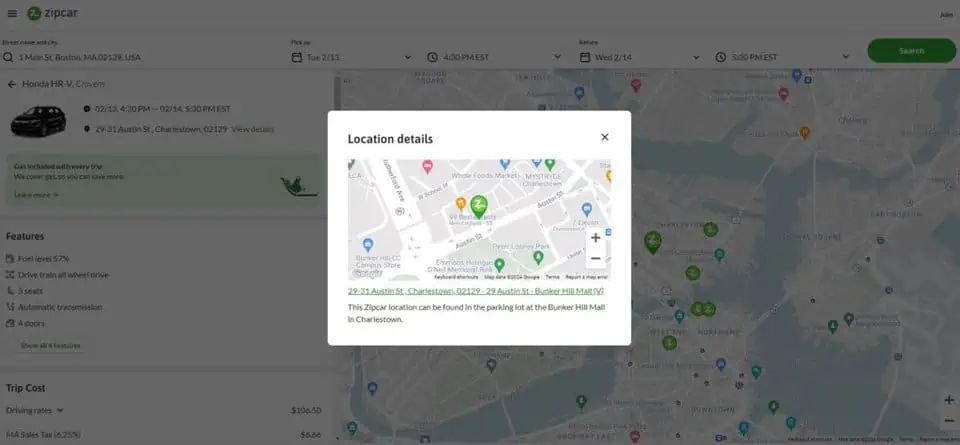
Once you’ve selected a vehicle, make sure to look through the fees.
The booking details will individually break down the pricing, but excludes fees like the application fee, membership fee, and young driver fee for new members.
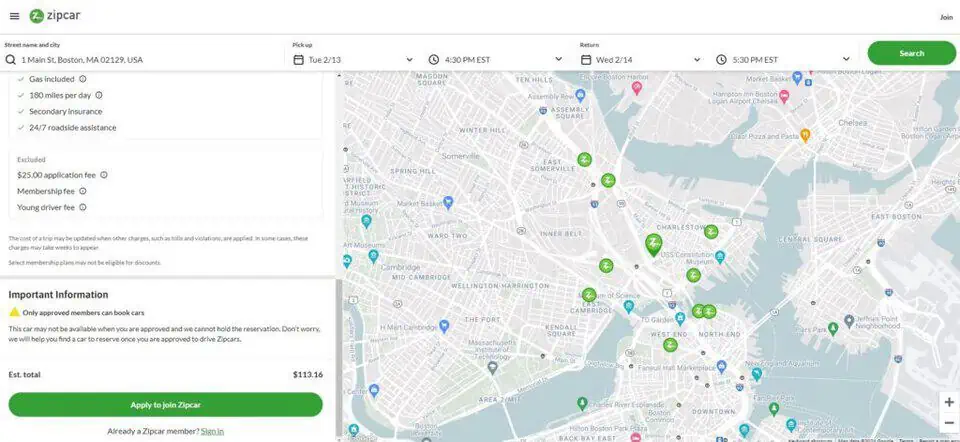
It’s also worth noting that as a first-time user, your booking will not be held until you become an approved member.
With Zipcar, you pay to play. If you don’t have a membership, they won’t hold your reservation.
When you try to book a vehicle, you’ll see this screen – their memberships:
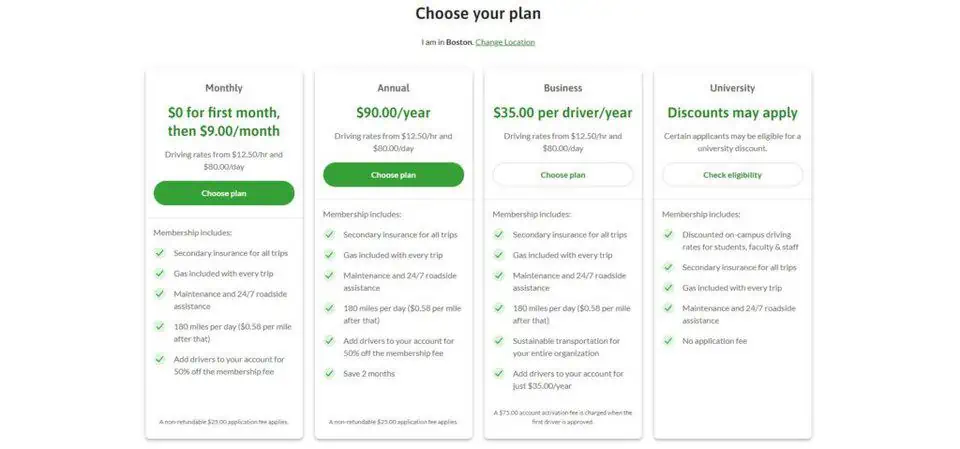
If you’re trying Zipcar for the first time, I’d suggest going with the Monthly plan. It’s free for the first month, then $9 per month after that.
While, yes, you can save $18 (2 months of the monthly plan) by choosing the annual option, if you don’t use the plan, you’re out all that money.
If you’re a student, though, I suggest checking out the University plan. Zipcar offers students discounts, so this is a great way to get around campus without a car.
After subscribing and booking the car you like, you’ll have all the vehicle information under “My Trips.” Zipcar will also send you a confirmation email with all the details.
From there, locating the car is simple, as you’ll have its exact location in the app. You can also turn on your phone’s Bluetooth to track the vehicle.
Unlocking and Accessing Your Zipcar
Depending on your membership, you can have a physical Zipcard that locks and unlocks the cars, linking them to your account.
If you don’t, there’s no need to worry. All Zipcars have Bluetooth technology, allowing you to unlock the booked vehicle.
Before starting your trip, it’s crucial to inspect the car thoroughly. This way, you’ll avoid any extra charges for damages that you didn’t cause.
First, report any cleanliness issues in the car, such as odor, smoking signs, or trash. Then, move on to the exterior, uploading pictures and rating its overall condition.
As for the Zipcar gas card, it should be in the visor. If it’s missing, contact Zipcar customer support.
Brett’s Take: Thoughts From an Expert
Overall, I think Zipcar does a very good job with making sure vehicles are available, well-maintained, and clean.
However, sometimes things happen. I’ve heard mixed opinions on the condition of the rental vehicles – from being found easily and clean, to vehicles being dirty and poorly maintained.
I suggest going in with an open mind and not setting expectations too high.
That way, if you do have a vehicle that seems to have small issues, it’s not a big deal. You still have a car.
Understanding Zipcar Fees and Charges
Zipcar offers an affordable car-sharing service without the extra costs of insurance, maintenance, or gas – these are all included in the rental price.
However, when you join Zipcar, there’s a one-time, non-refundable fee of $25. Additionally, membership fees are charged either monthly or annually, based on the plan you select.
Trip Cost
When reserving a car, it can have a daily or hourly rate with upfront pricing. What you see is what you pay.
Keep in mind that the driving rate changes from one vehicle to the other. For example, a Mercedes-Benz costs about $17 an hour, while a Honda Civic has an hourly rate of only $11.
Gas
Unlike most Zipcar alternatives, gas is complementary. You should find the gas card in the vehicle.
In case the gas card is missing, you’ll pay for gas as you normally would. After that, you’ll submit the gas receipts to Zipcar for reimbursement.
Extra Charges
The best part about Zipcar is that there aren’t any hidden fees. Still, you might find that you’ve been charged extra after the trip is over. This can be due to any of the following:
- Exceeding the mileage limit
- Tolls
- Late returns
- Low gas fees
During Rental: Rules and Tips
To get a smooth experience while using Zipcar, you must understand the platform’s rules.
This will prevent you from getting overcharged or banned from the application. Here are the most important guidelines to follow:
Mileage Limits
When driving a Zipcar, there are mileage limits to be aware of. While there are no hidden charges, the cost of renting the vehicle includes only 180 miles per day.
If you exceed this limit, you’ll be charged $0.58 for each additional mile.
Traffic Violations
Needless to say, you need to be careful when driving a rental. Not only do you want to avoid compromising your safety or endangering others, but major traffic violations can also get you banned from the carsharing platform.
It’s important to understand that Zipcar can take a while to alert you of a traffic violation. The rental company will probably pay for the violation and bill your credit card.
In case that doesn’t happen, you’ll be responsible for the charge.
You can always dispute the ticket, but if Zipcar determines that you’re responsible for the fee, you’ll be charged for the violation plus a $30 processing fee.
That’s not all. If you fail to pay your ticket on time, Zipcar will pay for it and charge your card for the total amount plus the processing fee.
Low Gas
After the trip, the gas tank must be at least ¼ full. You don’t need to pay for gas, as you can charge it to the Zipcar gas card. However, if you return a Zipcar with less than ¼ tank full of gas, the platform will charge you.
Cleanliness
You must treat your Zipcar as if it were your personal vehicle. This means no stains or scratches. You’ll need to deliver the vehicle as you found it. Then, the next driver will inspect it.
For this reason, you should carefully inspect the vehicle before your trip. If there are any issues, report them to Zipcar so that you won’t get stuck with the bill!
If there’s any animal fur, signs of smoking, foul odor, or trash, Zipcar will also have to charge you damage fees.
Returning Your Zipcar
Returning the Zipcar is incredibly easy. All there is to it is parking the vehicle in the same parking spot where you found it.
Leave the gas card in the visor and the keys in the car. You’ll then be able to lock the Zipcar using your application. Don’t forget to return the car with at least a ¼ full tank of gas.
What’s more, you should pay close attention to your reservation time. Zipcar can be worth it, but returning the car late will subject you to a $50 fee.
If the car is still available, you can always book it for an extra hour. This should give you enough time to fuel up, clean the car, and park it in the correct location on time.
While you’ll still be paying more, the rate is significantly less than the late return.
Zipcar Support and Troubleshooting
Many users of car rental apps often wonder how to contact customer service. While the online platforms make it easier to do so, finding help when you need it can be tricky.
| Method | Contact Information | Purpose |
|---|---|---|
| Phone | 866-4ZIPCAR | General inquiries, issue resolution, car reservations, accident reporting. |
| Online Help Center | N/A | For self-service answers to common questions. |
support@zipcar.com | Non-urgent questions. Include details and images of your issue. Response may take days. | |
| Accident Reporting | Use phone number | Immediate contact required. Follow up with a police report, document the incident, collect information. |
| Claims Management | Sedgwick CMS | For handling claims and liability coverage after an accident. |
| Damage Fee | Up to $1,000 | Applicable in the event of an accident involving a Zipcar. |
That’s not the case with Zipcar, though. You can easily reach customer support by calling 866-4ZIPCAR. They’ll assist you with any questions, solve all issues, and can even reserve a car for you.
If your inquiry is simple, you can try Zipcar’s online help center. There, you’ll find the answers to all your questions.
You can also contact Zipcar support at support@zipcar.com. Clearly describe your issue, including images if possible. This should be for non-urgent questions, though, as it’ll take a couple of days to receive a reply.
In the event of an accident, you need to contact Zipcar immediately and report the incident by phone. You must also file a police report, thoroughly document the incident, and collect information.
From there, Sedgwick CMS will handle the claim and liability coverage. Unfortunately, until the incident is over, your Zipcar account can get suspended.
You’ll also be required to pay a damage fee, which can cost up to $1,000.
Brett’s Take: Thoughts From an Expert
Overall, I recommend Zipcar to those looking for a car. However, the best use case seems to be short-duration rentals, such as errands or day trips.
This service is especially convenient for those who just need occasional access to a car.
The ability to book cars located nearby and the avoidance of long-term parking and maintenance concerns are significant advantages.
For longer rentals, traditional car rental services might offer better value due to Zipcar’s hourly rates and daily mileage limits.
Some platforms and services cater specifically to long-term rentals, offering quality vehicles at reasonable price points.
Frequently Asked Questions
What are the disadvantages of Zipcar?
Zipcar, while highly regarded, has its drawbacks, notably its strict policies on late returns and minor damages. Users are charged for even small scratches, and responsibility for repairs from unavoidable incidents like rain, wind, or floods falls on the user.
How many miles are free with Zipcar?
Zipcar gives you a whopping 180 miles for free every 24 hours. If you’ve reserved a car for a week, you’ll get 180 miles per day, regardless of how far you drove the previous day.
Can you get banned from Zipcar?
Yes, you can be banned from Zipcar for breaking the rules, especially after major accidents, leading to immediate account suspension. However, for minor issues like cleanliness or late returns, Zipcar typically issues a fee and a warning rather than a ban.
Wrapping Up
Zipcar is one of the best car sharing platforms around. It’s a cost-efficient solution to your transportation needs.
The best part is that the sign-up process is simple, and there are no hidden fees. Instead, you only pay a membership fee, which can be monthly or annually. Then, you’ll find the trip cost for your preferred vehicle without any extra charges.
After your trip, clean the car and fill the gas tank until it’s ¼ full. Return the vehicle to the same location, and that’s it.
So, now that you know how simple this platform is, don’t forget to follow our rules and tips for a smooth experience!


